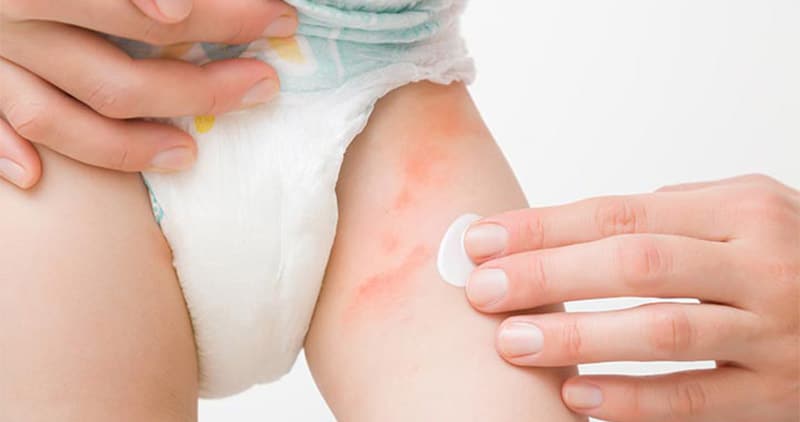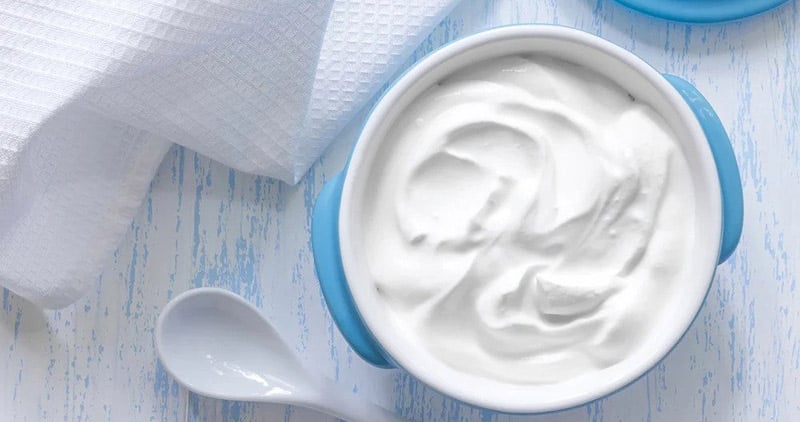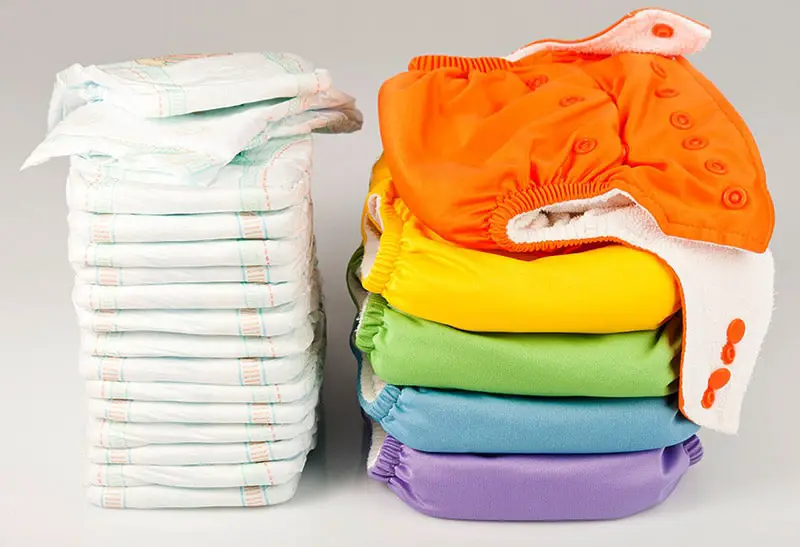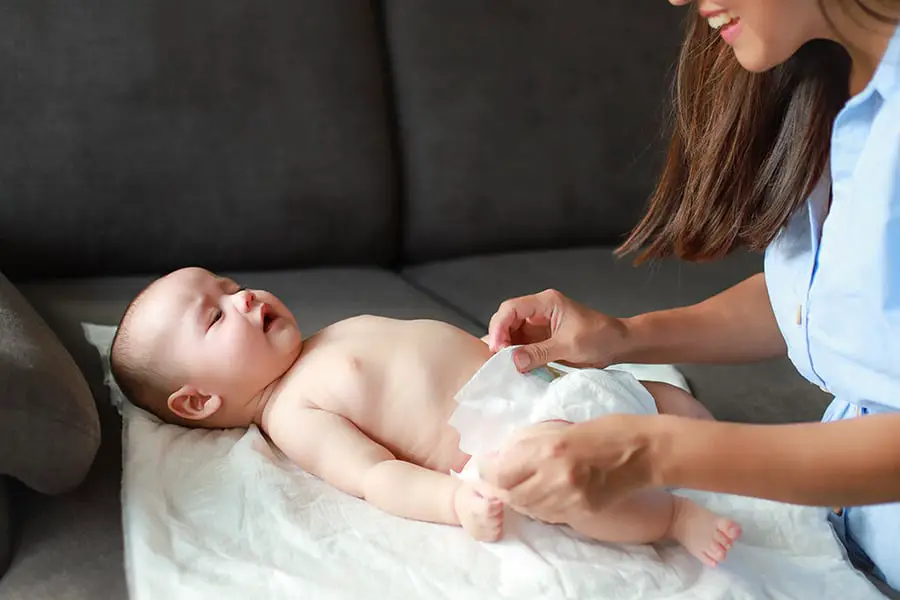Diaper rash is a common problem that many babies and toddlers have.
While it usually subsides on its own in a few days, you shouldn’t wait too long to address it. Diaper rash can make a baby grumpy and uncomfortable.
Fortunately, there are several home remedies for diaper rash you can try to heal your baby’s delicate skin. This article is here to help you know more about them.
What Is A Diaper Rash?

Diaper rash is inflamed skin that appears as a patchwork of bright red on your child’s bottom.
Although diaper rash may seem a severe problem, it’s relatively simple to cure with the correct natural home remedy and more regular diaper changes.
Also known as diaper dermatitis, the condition is a common skin condition that affects babies and toddlers. It may affect every kid who wears a diaper, ranging from minor to severe.
Causes of Diaper Rash
Diaper rash may affect diaper wearers of any age and is most likely to develop when your child:
- Has a pair of overly tight diapers
- Sleeps during the night and requires fewer diaper changes
- Shifts from baby food to solid meals
- Prescribed an antibiotics
- Has a cold or diarrhea
- Has sensitive skin
- Has inflamed skin
- Has yeast infection or bacterial infection
Diaper rash is caused by friction from frequent movement and dampness. Certain soaps, as well as diapers and wipes, may cause allergies in newborns and toddlers.
Types of Diaper Rash
There are the two most common kinds of diaper rash. It is critical to diagnose your child’s rash to treat it correctly.
Diaper Dermatitis
Diaper dermatitis is the most frequent diaper rash caused by irritation from the diaper’s contents or the diaper itself.
Diaper dermatitis shows little red spots that may evolve into sores that bleed and get infected in severe instances.
Yeast Diaper Rash
Infections caused by yeast might resemble diaper dermatitis, but they can also include white blisters or swollen regions with a scaly, white outer layer.
These blisters may get infectious if they rupture.
The Best Home Remedies for Diaper Rash
While certain natural baby lotions and diaper rash products may help soothe a baby’s delicate skin without harsh or drying chemicals, a few natural remedies for diaper rash may also help soothe the skin and promote healing.
Reminder: Stop taking the cure and see your physician if it doesn’t work after a few days or if the symptoms worsen.
Apple Cider Vinegar

Your baby’s skin might become overly alkaline if they remain in a wet or soiled diaper for too long.
Combine apple cider vinegar and water and soak your baby’s bottom for at least 10 minutes. Let it air dry, then apply a natural moisturizing moisturizer after that.
Aloe Vera Juice or Gel
Aloe vera juice helps heal your baby’s irritated skin. Using your fingertips, dab a tiny quantity of aloe vera gel over the afflicted regions. Aloe vera is antibacterial and its antioxidants speed up healing.
Baking Soda
Baking soda aids in neutralizing the acidity and germs caused by the baby’s rash. For immediate relief, combine two teaspoons of baking soda with lukewarm water and massage to your baby’s bottom with a soft cloth.
Baking soda helps regulate pH levels and eliminates germs and fungus from the newborn’s skin.
Oatmeal Bath
According to research, colloidal oatmeal may help with atopic dermatitis and other inflammatory skin disorders by reducing inflammation and irritation caused by diapers.
You may alleviate diaper rash discomfort by using colloidal oatmeal.
Oatmeal bath treatments are available at a variety of pharmacy shops and online. People should follow the package’s instructions and pat the baby’s skin dry.
Coconut Oil
Coconut oil is one of the most effective cures for diaper rash in newborns because of its antifungal, antibacterial, and anti-inflammatory properties.
Your baby’s bottom should be washed in warm water and dried with a soft cloth. After the baby’s bath, take half a spoonful of coconut oil and apply it to the afflicted region.
You may efficiently treat yeast diaper rash with coconut oil. Coconut oil also helps moisturize sensitive skin.
Plain Yoghurt

You may treat painful rash and irritation with plain yogurt (without added sugar or cornstarch). Apply a thick yogurt coating to the affected skin, and the rashes should go away in a few days.
Use it the same way as diaper rash creams. Apply room-temperature yogurt to the afflicted region before covering it with a diaper.
Breast Milk
Apply a few drops of breast milk to the afflicted region of the rash and let it dry. After you’ve tried this cure, put on new diapers for the most excellent results.
Diaper Rash Cream
You don’t always have to buy diaper rash creams from your local store. There are actually alternatives you can use.
Vaseline jelly, for example, may be perfect since it is affordable and typically contains fewer colors and scents.
Jellies, on the other hand, may adhere to cloth diapers and be challenging to remove. They also don’t provide as effective a barrier as other lotions.
Tips for Avoiding Diaper Rash
There are several ways to help avoid diaper rash, including:
1. Change diapers as soon as it gets moist or dirty.
To avoid diaper rash, you can change your baby’s diaper as soon as it becomes moist or dirty.
Even if the diaper is just slightly damp, changing it will lessen the amount of moisture on your baby’s bum, lowering the likelihood of a rash.
A little retained moisture is all it takes to irritate the skin and induce a rash. That’s why wet or mildly damp diapers should be changed very soon, particularly if your kid has an active diaper rash.
2. Be gentle when washing the diaper region.
Use a soft washcloth, water, and fragrance-free, alcohol-free baby wipes. Pat the skin gently, but do not massage it. Use wipes that are best for sensitive skin.
3. Allow for thorough drying of the skin.
Allow your baby’s skin to air dry fully after cleansing to help it mend quicker. Allow your child to be diaper-free for as long as possible until the skin is totally dry. For example, you can let your baby stay on his play mat while you’re letting his bottom dry.
Don’t scrub your skin too hard, and avoid alcohol-based wipes. When your kid has a rash, it might also be beneficial to let them go without a diaper for a while.
Place towels or disposable waterproof pads on the floor to give your kid some diaper-free time.
4. Use disposable diapers instead of cloth diapers.

Cloth diapers offer many advantages, but they aren’t the ideal option if your kid has a diaper rash.
Switching to super-absorbent disposable diapers while the diaper rash heals may help. They’ll keep your baby completely dry and speed up the healing process.
5. Make sure your child’s diaper is the right size.
When you use the incorrect size diaper, you increase your chances of getting diaper rash, making it more difficult for an existing rash to heal.
An excessively tight diaper might cause extra moisture and quicker rash development. An overly big diaper might irritate and generate friction, which aggravates rashes.
Make sure your child’s current diaper size is correct. Changing your size might help.
6. Stay away from scented products.
When it comes to diaper rash prevention and treatment, less is more. Avoid using items with strong scents, such as fabric softeners and dryer sheets. Generally speaking, you shouldn’t just be concerned with paint products for nurseries; you should also be careful about scented products for babies.
For many newborns, hypoallergenic and fragrance-free products are much less irritating.
You should also avoid using baby powder on your child. It’s dangerous for newborns to inhale since it may injure their lungs.
7. Eliminate new foods from your baby’s diet.
While it is generally healthy to introduce new foods to newborns, some acidic meals, such as citrus fruits and tomatoes, may cause their urine and feces to become highly acidic and unpleasant.
Parents and caregivers should start with tiny amounts of these meals and keep an eye on the baby to see if a new diaper rash appears simultaneously.
If this is the case, you should eliminate acidic foods from the infant’s diet until the rash has healed.
8. If symptoms worsen, call your doctor right away.
Make an appointment with your physician if the rash doesn’t go away after a few days or if it grows worse – or keeps coming back.
When to See A Doctor

Diaper rashes usually heal and go away in a few days. Most parents turn to home cures for diaper rash, but they don’t always work.
If you detect any of the following symptoms in your infant, you should take your baby to the doctor:
- Fever
- Swelling
- Blisters
- A rash that doesn’t go away
You can try any simple home remedies for diaper rash we shared above.
Consult a pediatrician if the diaper rash is severe (i.e., you observe the symptoms mentioned above) and does not go away within one week.







